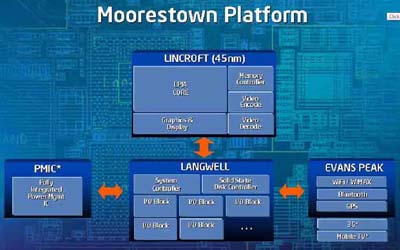About Atom: Intel's big plans for its little chip

One of the bolder goals Intel set at IDF this week is that within a decade it wants ship 1 billion Intel-based mobile computing devices each year. That's a big bet when you consider Intel estimates there will be a total of 163 million notebooks shipped this year.
Notebooks have been coming on strong, but the Atom processor for smaller devices is also a key part of this strategy. In a session on Atom, Intel executives discussed the performance of the current Atom processor and its Menlow platform, and gave us a peek at its successor, Moorestown, scheduled to ship next year.
Menlow consists of the Atom processor and a system controller that combines the functions of the north and south bridges including a low-power 3D graphics core. Ticky Thakkar, an Intel fellow and chief architect of the ultra mobility group, showed tests results in which the 1.1GHz Atom Z510 and 1.6GHz Atom Z530 delivered more than twice the performance of the latest ARM processors, which are used in many smartphones. But Menlow is still too big, and uses too much power, for many of the gadgets that use ARM-based processors today. That's where Moorestown comes in.
A sneak peek at Moorestown For the next platform, Intel "repartitioned" the architecture to make it more of a System-on-Chip (SoC) design. The Lincroft CPU will still be manufactured using a 45nm process, but it will include the graphics processing, memory controller and video decoding and encoding on a single chip. The Langwell system controller hub will include power management, a full SSD controller and a number of new I/O features "which I'm not going to talk about today," Thakar said. Finally Moorestown includes a new class of chip, a Power Management IC or PMIC, that handles the power delivery and battery charging circuitry.
At first glance, this would seem to undermine Intel's goal of a more-integrated design. But the PMIC replaces many of the active and passive elements--what Intel calls "jelly beans"--which sit on a typical system board. This effort started with Menlow, which has about 600 of these jelly beans, compared with 1,100 in a typical laptop, according to Thakar. Reducing these jelly beans cuts cost, and makes it possible to build smaller devices.
One other note on Moorestown: The Echo Peak wireless chipset in Menlow will be replaced with an Evans Peak chipset that adds GPS to a menu that already includes WiFi, WiMax and Bluetooth. "Additionally we will also have a 3G solution in this timeframe," Thakar said, though he declined to give any details.
Moorestown is on track for 2009-2010. To prove it, during his keynote, Anand Chandrasekher, the senior vice president and general manager of Intel's ultra mobility group, showed a wafer containing the "first silicon" for Moorestown.
The rise of netbooks Currently, the Menlow platform is used three different types of gadgets: Mobile Internet Devices or MIDs, netbooks and nettops. Intel continues to show off MIDs from Lenovo, Fujitsu, Clarion and others, but the rollout of a Mobile WiMax wireless broadband--a key enabling technology--is behind schedule and MIDs, like UMPCs before them, still seem like a solution in search of a problem. Instead Atom has found a home in notebooks which have morphed from a "One Laptop Per Child" sort of product to a much broader market--a development that seems to have caught Intel by surprise.
"All of these [netbooks] are wonderful. When we envisioned the netbook, we thought it was going to be predominantly for emerging markets," said Dadi Perlmutter, Intel's executive vice president and general manger of mobile platforms, in his keynote. "But we are surprised, happily surprised, to see that this technology is also being desired in mature markets."
The dual-core Atom processor arrives Finally, Intel also announced the first dual-core Atom processor, the Atom 330, paired with a new mini-ITX format motherboard--both of which are designed specifically for a third category of Menlow products: nettops. Like their mobile counterparts, these are basic desktops designed for both emerging markets and as a second or third PC in households in mature markets. The Asus Eee Box and MSI Wind PC are two examples. (Intel says the mini-ITX board and Atom chips may also be used in Internet kiosks, thin clients and point-of-sale systems.) One of the problems with these systems is that some mini-ITX components are actually more costly than standard desktop components, so it is tough to build nettops that are much cheaper than full-fledged budget PCs, though if the nettop volumes increase, that will change.
Still it's clear that the primary market for Atom is mobile devices. During his keynote, Perlmutter showed Intel's estimates for worldwide computer shipments through 2012, which illustrate just how fast notebooks, and increasingly Atom-based mobile devices, are expected to grow--and how important they've become to Intel's strategy.
